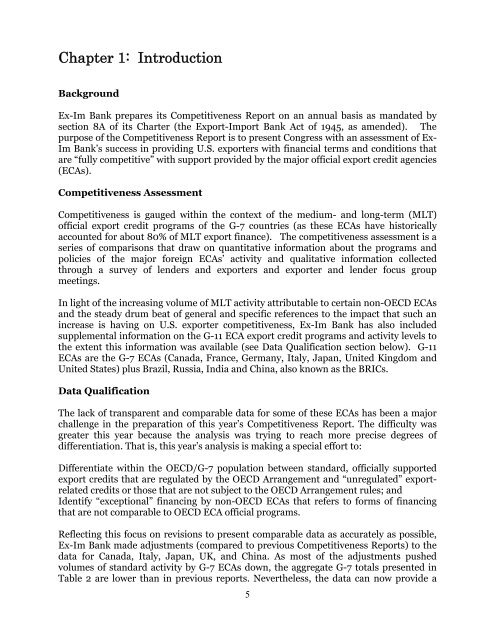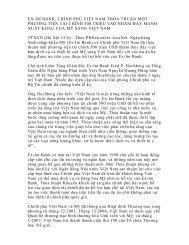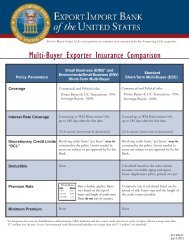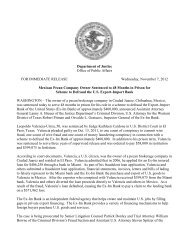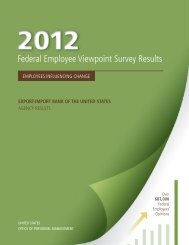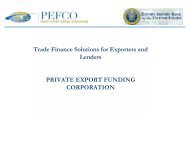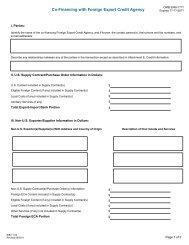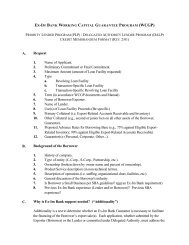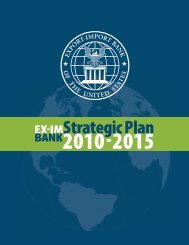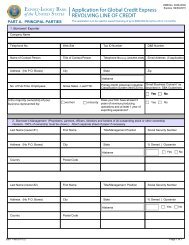2010 Competitiveness Report - Export-Import Bank of the United ...
2010 Competitiveness Report - Export-Import Bank of the United ...
2010 Competitiveness Report - Export-Import Bank of the United ...
Create successful ePaper yourself
Turn your PDF publications into a flip-book with our unique Google optimized e-Paper software.
Chapter 1: Introduction<br />
Background<br />
Ex-Im <strong>Bank</strong> prepares its <strong>Competitiveness</strong> <strong>Report</strong> on an annual basis as mandated by<br />
section 8A <strong>of</strong> its Charter (<strong>the</strong> <strong>Export</strong>-<strong>Import</strong> <strong>Bank</strong> Act <strong>of</strong> 1945, as amended). The<br />
purpose <strong>of</strong> <strong>the</strong> <strong>Competitiveness</strong> <strong>Report</strong> is to present Congress with an assessment <strong>of</strong> Ex-<br />
Im <strong>Bank</strong>’s success in providing U.S. exporters with financial terms and conditions that<br />
are “fully competitive” with support provided by <strong>the</strong> major <strong>of</strong>ficial export credit agencies<br />
(ECAs).<br />
<strong>Competitiveness</strong> Assessment<br />
<strong>Competitiveness</strong> is gauged within <strong>the</strong> context <strong>of</strong> <strong>the</strong> medium- and long-term (MLT)<br />
<strong>of</strong>ficial export credit programs <strong>of</strong> <strong>the</strong> G-7 countries (as <strong>the</strong>se ECAs have historically<br />
accounted for about 80% <strong>of</strong> MLT export finance). The competitiveness assessment is a<br />
series <strong>of</strong> comparisons that draw on quantitative information about <strong>the</strong> programs and<br />
policies <strong>of</strong> <strong>the</strong> major foreign ECAs’ activity and qualitative information collected<br />
through a survey <strong>of</strong> lenders and exporters and exporter and lender focus group<br />
meetings.<br />
In light <strong>of</strong> <strong>the</strong> increasing volume <strong>of</strong> MLT activity attributable to certain non-OECD ECAs<br />
and <strong>the</strong> steady drum beat <strong>of</strong> general and specific references to <strong>the</strong> impact that such an<br />
increase is having on U.S. exporter competitiveness, Ex-Im <strong>Bank</strong> has also included<br />
supplemental information on <strong>the</strong> G-11 ECA export credit programs and activity levels to<br />
<strong>the</strong> extent this information was available (see Data Qualification section below). G-11<br />
ECAs are <strong>the</strong> G-7 ECAs (Canada, France, Germany, Italy, Japan, <strong>United</strong> Kingdom and<br />
<strong>United</strong> States) plus Brazil, Russia, India and China, also known as <strong>the</strong> BRICs.<br />
Data Qualification<br />
The lack <strong>of</strong> transparent and comparable data for some <strong>of</strong> <strong>the</strong>se ECAs has been a major<br />
challenge in <strong>the</strong> preparation <strong>of</strong> this year’s <strong>Competitiveness</strong> <strong>Report</strong>. The difficulty was<br />
greater this year because <strong>the</strong> analysis was trying to reach more precise degrees <strong>of</strong><br />
differentiation. That is, this year’s analysis is making a special effort to:<br />
Differentiate within <strong>the</strong> OECD/G-7 population between standard, <strong>of</strong>ficially supported<br />
export credits that are regulated by <strong>the</strong> OECD Arrangement and “unregulated” exportrelated<br />
credits or those that are not subject to <strong>the</strong> OECD Arrangement rules; and<br />
Identify “exceptional” financing by non-OECD ECAs that refers to forms <strong>of</strong> financing<br />
that are not comparable to OECD ECA <strong>of</strong>ficial programs.<br />
Reflecting this focus on revisions to present comparable data as accurately as possible,<br />
Ex-Im <strong>Bank</strong> made adjustments (compared to previous <strong>Competitiveness</strong> <strong>Report</strong>s) to <strong>the</strong><br />
data for Canada, Italy, Japan, UK, and China. As most <strong>of</strong> <strong>the</strong> adjustments pushed<br />
volumes <strong>of</strong> standard activity by G-7 ECAs down, <strong>the</strong> aggregate G-7 totals presented in<br />
Table 2 are lower than in previous reports. Never<strong>the</strong>less, <strong>the</strong> data can now provide a<br />
5


